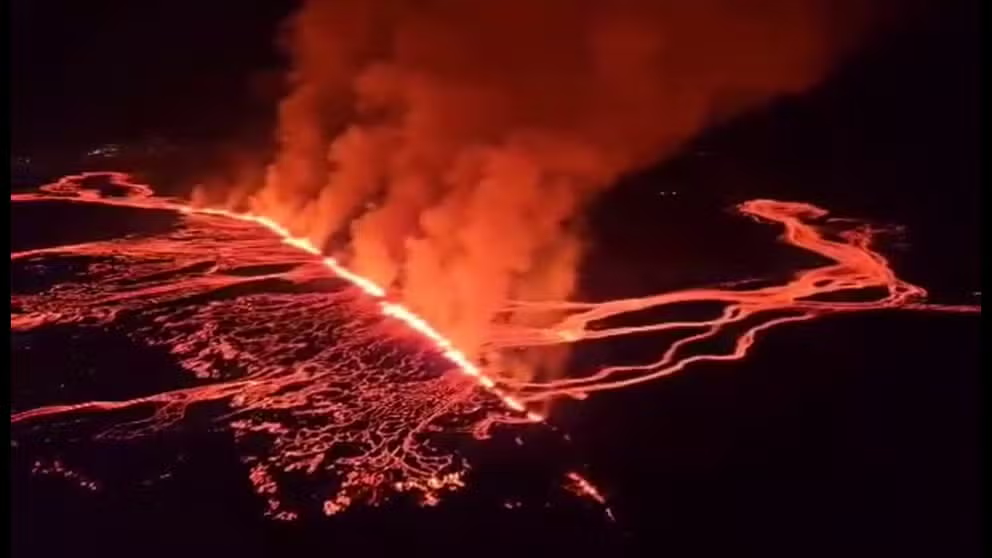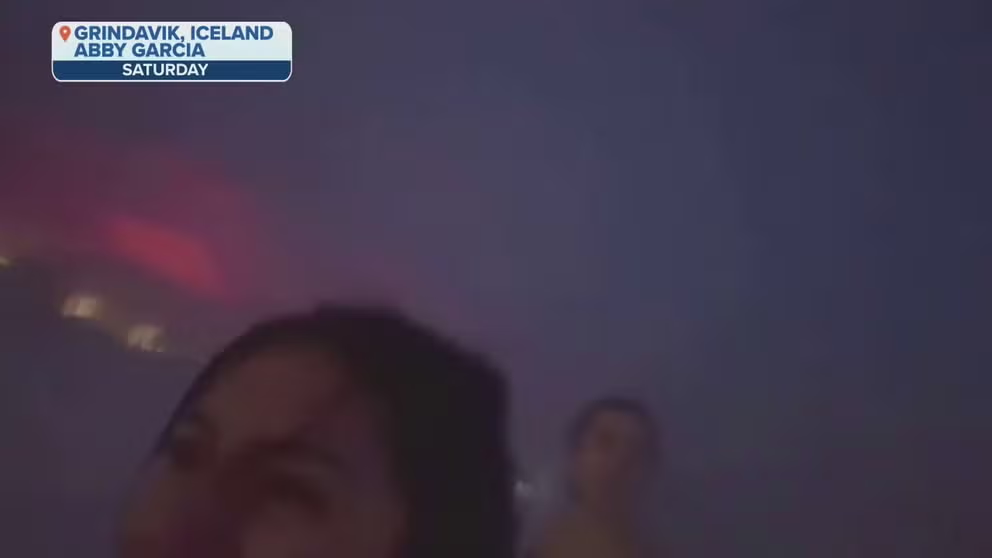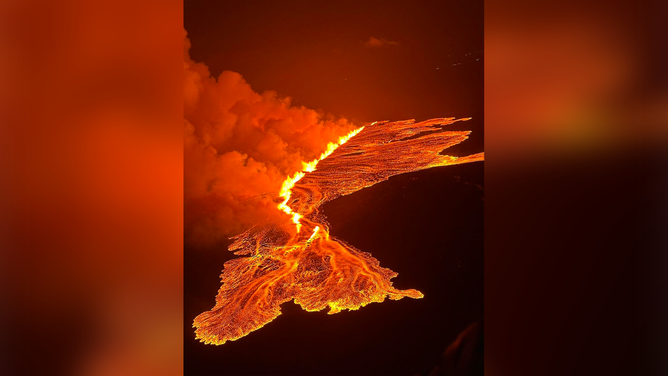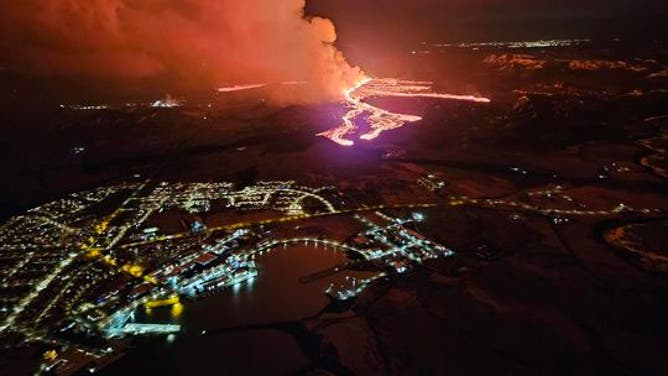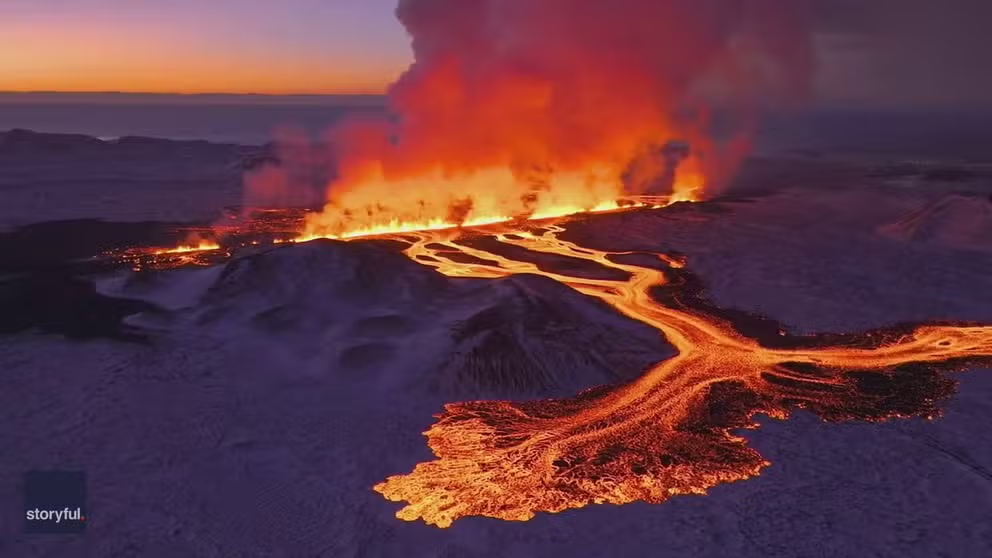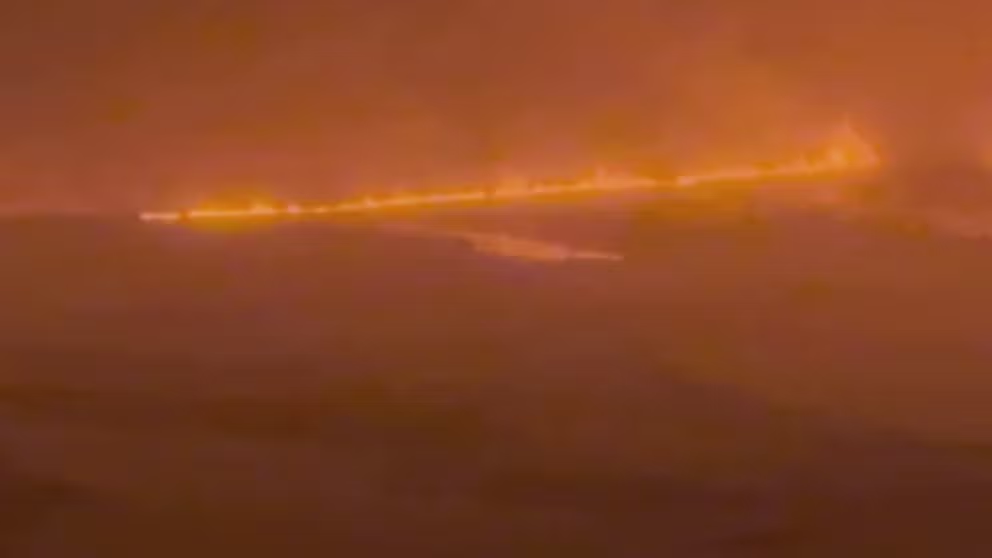Iceland volcano continues to spew lava but eruption has stabilized, scientists say
According to the Iceland Meteorological Office (IMO), the first warning to Iceland’s Department of Civil Protection and Emergency Management of an impending eruption was received at 7:43 p.m. local time (3:43 p.m. EDT), and the onset of the eruption was confirmed via web cameras about 40 minutes later, just before 8:30 p.m. local time (4:30 p.m. EDT).
Volcano in Iceland erupts for fourth time in 3 months
A state of emergency was declared in Iceland after a volcano erupted for the fourth time in three months on Saturday, March 16, 2024.
GRINDAVIK, Iceland – Scientists in Iceland said that a volcanic eruption that began over the weekend has finally started to stabilize, but lava is continuing to flow from two areas of a nearly 2-mile-long fissure that opened up just outside the evacuated seaside town of Grindavík.
Saturday’s eruption began with little warning just before 8:30 p.m. local time (4:30 p.m. EDT) and was the fourth reported in the area since December. The region has been rocked by volcanic eruptions several times since 2021, and officials say Saturday’s eruption was likely the largest that has occurred over the past three years.
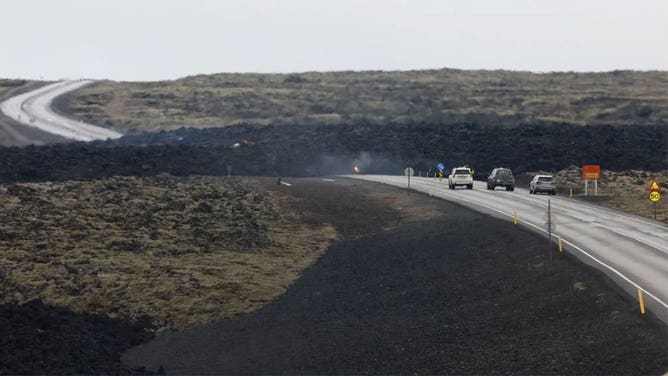
Emergency services are seen near to the site of the volcanic eruption on March 17, 2024 in Grindavik, Iceland. The Icelandic Meteorological Office confirmed a volcanic eruption started between Stora Skogfell and Hagafell on Saturday evening, the fourth time since December. A state of emergency has been declared in and around the town of Grindavik and hundreds of holidaymakers have been evacuated from the popular Blue Lagoon spa, which lies a short distance northwest of the site of the volcano.
(Micah Garen / Getty Images)
The Iceland Meteorological Office (IMO) said in an update Monday that volcanic activity was located mostly in the southern parts of the fissure that opened during the eruption’s onset, while activity in the northernmost vents appears to have subsided.
Lava continues to flow from those vents, but the IMO said those lava flows seemed to be moving very slowly as observations showed there wasn’t much movement since Sunday.
However, the lava that did flow when the eruption began has covered a large area of the landscape.
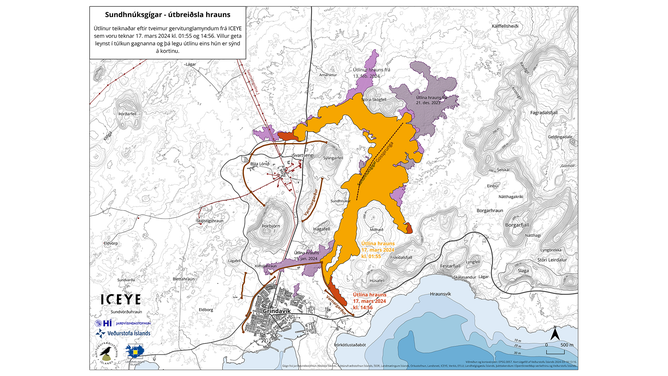
This graphic shows the estimated size of the lava flow outside Grindavik in Iceland.
(Iceland Meteorological Office)
The IMO said that the area of the lava was estimated to be about 2.25 square miles based on satellite observations Sunday.
"The area estimate has greater uncertainty than measurements based on aerial photographs," the IMO said.
Video shows Iceland volcano erupting for fourth time in 3 months
A video recorded from an Iceland Coast Guard helicopter shows the eruption of a volcano near the seaside town of Grindavik. This is the fourth time the volcano has erupted since December.
This is because the weather in the area continues to be less than ideal. Scientists were hopeful that flights over the eruption for more accurate estimates could occur Monday if the weather improved.
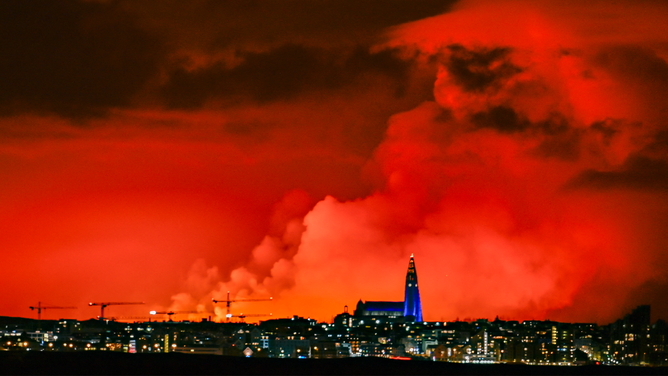
The skyline of Reykjavik is against the backdrop of orange coloured sky due to molten lava flowing out from a fissure on the Reykjanes peninsula north of the evacuated town of Grindavik, western Iceland on March 16, 2024. Lava spewed Saturday from a new volcanic fissure on Iceland's Reykjanes peninsula, the fourth eruption to hit the area since December, authorities said. (Photo by Halldor KOLBEINS / AFP) (Photo by HALLDOR KOLBEINS/AFP via Getty Images)
(Getty Images)
Videos and photos from the area after the eruption began showed lava flowing in all directions from the fissure.
Another dramatic photo showed the sky above Iceland’s capital city of Reykjavik glowing an eerie orange color with thick clouds of smoke billowing in the background.
Iceland’s Blue Lagoon to remain closed
Watch: Sirens wail at Iceland's Blue Lagoon as fourth volcanic eruption in 3 months begins
Tourists at Iceland's famous Blue Lagoon resort recorded video when a volcano in the area began to erupt for the fourth time in three months on Saturday, March 16, 2024. Sirens could be heard wailing in the background warning people to evacuate the area.
What had been a peaceful night at Iceland’s Blue Lagoon resort quickly transformed into feelings of uneasiness when the eruption began on Saturday evening.
Video recorded by tourists at the Blue Lagoon the moment the eruption began showed the sky beginning to turn orange from the lava that was flowing from the volcano as sirens wailed, warning people to flee the area.
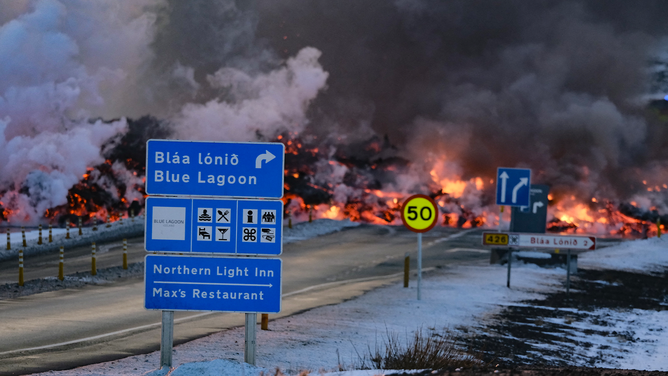
FILE - Molten lava is seen overflowing the road leading to the famous tourist destination "Blue Lagoon" near Grindavik, western Iceland on February 8, 2023. A volcanic eruption started on the Reykjanes peninsula in southwestern Iceland on Thursday, the third to hit the area since December, authorities said. (Photo by Kristinn Magnusson / AFP) / Iceland OUT (Photo by KRISTINN MAGNUSSON/AFP via Getty Images)
(Getty Images)
As it had done so since the first eruption at the end of 2023, Blue Lagoon quickly and safely closed the facility and evacuated guests and staff from the area.
While the eruption site is "at a safe distance from Blue Lagoon," officials said that it will remain closed through at least Tuesday.
"We will continue to closely follow the guidelines and recommendations of the authorities, working collaboratively with them to monitor the progression of events," Blue Lagoon said in a statement on its website. "This commitment aligns with our unwavering dedication to ensuring the safety and wellbeing of our valued guests and staff."
Defense walls built near Grindavík holding strong
Before the initial eruption in December, work was started to construct defensive barriers around Grindavík, as well as near Blue Lagoon, to protect homes and critical infrastructure from potential lava flows.
While some homes were destroyed by lava during a previous eruption, it appears as though the fortifications this time around are holding strong.
The IMO said lava flows have been running alongside the protective barriers east of Grindavík and toward a main road in the area.
According to national public broadcaster RÚV, the fortifications are doing what they were built to do – protect the seaside town of Grindavík.
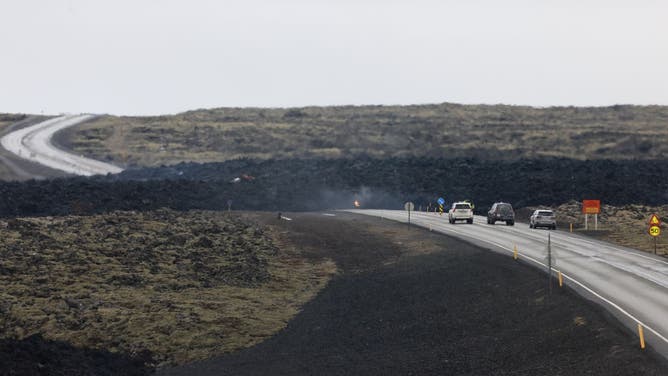
Emergency services are seen near to the site of the volcanic eruption on March 17, 2024 in Grindavik, Iceland. The Icelandic Meteorological Office confirmed a volcanic eruption started between Stora Skogfell and Hagafell on Saturday evening, the fourth time since December. (Photo by Micah Garen/Getty Images)
(Getty Images)
"It is quite clear that if the defensive wall was not there, this lava would flow in a different and more unfortunate direction," the police chief told RÚV.
DRONE VIDEO SHOWS LARGE CRACKS SPLITTING ICELANDIC TOWN'S STREET AMID VOLCANIC THREAT
Dangers could arise if lava reaches the ocean
Watch: Drone video provides dramatic image of volcanic eruption in Iceland
Drone video recorded in Iceland shows the power of a volcano that erupted for the third time in two months on Thursday, Feb. 8, 2024.
With lava still flowing, the IMO said "the scenario of lava reaching the ocean needs to be considered."
Kristín Jónsdóttir, of the IMO, told RÚV that lava reaching the ocean could have many consequences.
"The main examples we look at are from Hawaii," she told RÚV. "We know that if lava, which is alkaline, comes into contact with the seawater, chlorine fumes can be produced. So, there will be a local danger as lava flows into the sea."
It’s not only toxic fumes that pose a threat.
"Another thing that could happen is that lava can become unstable where it meets the sea, and there can be minor explosions," she continued. "Therefore, the place where the sea and lava meet will always be dangerous."
The IMO and Civil Protection offices have been discussing contingency plans if the lava were to reach the sea. At its current rate, the lava would take about two days to reach the ocean, according to Iceland Civil Defense.
Iceland eruption is largest in years, scientists say
Watch: Airline passenger gets bird's-eye view of Iceland volcanic eruption
A tourist on a flight arriving at Iceland's Keflavik airport captured dramatic video of a volcano eruption that began near the town of Grindavik on Monday night. (Video from December 2023)
The volcano that erupted Saturday night has exploded several times since 2023, with four eruptions being reported since the end of last year alone.
The first occurred on Dec. 18, 2023, and the second was reported less than a month later on Jan. 14.
The third eruption occurred on Feb. 8, and the fourth occurred Saturday night.
Officials said Saturday’s eruption is probably the largest that has occurred since 2021.
Some information was translated via Google Translate.

